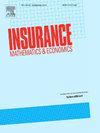Bayesian adaptive portfolio optimization for DC pension plans
IF 2.2
2区 经济学
Q2 ECONOMICS
引用次数: 0
Abstract
This paper investigates an optimally defined contribution (DC) pension fund problem with partial information. The fund manager invests his wealth in a financial market consisting of a risk-free asset, a stock, and an index bond. He aims to maximize the expected utility of the terminal wealth minus the minimum guarantee. The drift terms of the stock and the index bond are represented by unobservable random variables and the market price of risk follows a prior probability distribution. Using the Bayesian approach and filtering theory, we first transform the original unobservable optimization problem into one with full information. After that, we introduce an auxiliary process to convert the full information problem into an equivalent unconstrained self-financing optimization problem. We then solve the problem and obtain an explicit expression for the optimal investment strategy by using the martingale approach. To compare the results, we also derive the optimal investment strategy for the DC pension model under constant relative risk aversion (CRRA) utility in which the financial market is fully observable.
固定缴费养老金计划的贝叶斯自适应投资组合优化
本文研究了一个具有部分信息的最优设定缴存(DC)养老基金问题。基金经理将他的财富投资于由无风险资产、股票和指数债券组成的金融市场。他的目标是使终端财富减去最低担保后的预期效用最大化。股票和指数债券的漂移项由不可观测随机变量表示,市场风险价格服从先验概率分布。首先利用贝叶斯方法和滤波理论,将原不可观测优化问题转化为全信息优化问题。然后,引入一个辅助过程,将完全信息问题转化为等价的无约束自融资优化问题。然后利用鞅方法对问题进行求解,得到了最优投资策略的显式表达式。为了比较结果,我们还推导了在金融市场完全可观察的恒定相对风险厌恶(CRRA)效用下DC养老金模型的最优投资策略。
本文章由计算机程序翻译,如有差异,请以英文原文为准。
求助全文
约1分钟内获得全文
求助全文
来源期刊

Insurance Mathematics & Economics
管理科学-数学跨学科应用
CiteScore
3.40
自引率
15.80%
发文量
90
审稿时长
17.3 weeks
期刊介绍:
Insurance: Mathematics and Economics publishes leading research spanning all fields of actuarial science research. It appears six times per year and is the largest journal in actuarial science research around the world.
Insurance: Mathematics and Economics is an international academic journal that aims to strengthen the communication between individuals and groups who develop and apply research results in actuarial science. The journal feels a particular obligation to facilitate closer cooperation between those who conduct research in insurance mathematics and quantitative insurance economics, and practicing actuaries who are interested in the implementation of the results. To this purpose, Insurance: Mathematics and Economics publishes high-quality articles of broad international interest, concerned with either the theory of insurance mathematics and quantitative insurance economics or the inventive application of it, including empirical or experimental results. Articles that combine several of these aspects are particularly considered.
 求助内容:
求助内容: 应助结果提醒方式:
应助结果提醒方式:


